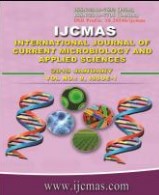


 National Academy of Agricultural Sciences (NAAS)
National Academy of Agricultural Sciences (NAAS)

|
PRINT ISSN : 2319-7692
Online ISSN : 2319-7706 Issues : 12 per year Publisher : Excellent Publishers Email : editorijcmas@gmail.com / submit@ijcmas.com Editor-in-chief: Dr.M.Prakash Index Copernicus ICV 2018: 95.39 NAAS RATING 2020: 5.38 |
The findings of present study suggested that the pH in soils neutral to slightly alkaline safe in electrical conductivity and low to medium in organic carbon content. Metals concentration was below the permissible limits at 200,400,600 and 800 m, from both side of Omati Nala, in rainy and winter seasons, respectively. In water, pH ranged from 6.5 to 8.5 and EC under permissible range. However, Pb and Cr were comparatively higher than the Indian permissible limits. The concentration of Ni, Cr and Cd in rice, wheat and Brinjal was higher than the limit given by WHO/Indian standard. The transfer factor was recorded for these metals in order of Brinjal, followed by the Spinach and Tomato. Result revealed that, the pH had negatively correlated with OC (r=-0.252*) and Cr (r=-0.413**) in rainy season and similar relationship with EC(r=-0.601**), OC (r=-0.356**), Cd (r=-0.696**) and Pb (r=-0.619**) in winter season. While, it had significant positive relationship with Cr (r=0.304**). In winter season, the EC had positive and significant relationship with OC (r=0.239*), Cd (r=0.366**) and Pb (r=0.420**). In rainy and winter seasons, the OC showed significant positive relationship with Ni (r=0.305**), Cd (r=0.279*) and Pb (r=0.232*) and Cd (r=0.333**) and Pb (r=0.240*) respectively. The Cd in soil showed significant and positively related with Ni and Cd content in plant. Multivariate analysis results revealed that, the variables are correlated with two principal components in which 64.61 and 66.89% of the total variance were extracted in rainy and winter seasons respectively. The first component with 40.56 and 43.56 % of variance comprises Ni Cd and Pb and pH, EC, OC, Cd and Pb with high loadings whereas; the second component contributes pH, EC, OC and Cr and Ni and Cr at 24.04 and 23.32% total variance in rainy and winter seasons, respectively. Clustering result grouped all sampling sites into nine and seven zones on the basis of spatial similarities among sites and differences among different groups in rainy and winter seasons, respectively. In rainy season, 1, 2, 3 and 4 zones were containing higher heavy metal concentrations than the zone 5,6,7,8 and 9 whereas in winter season, zone 1, 2, 3, 5 and 6 had higher concentrations of metals than the zone 4 and 7.
 |
 |
 |
 |
 |